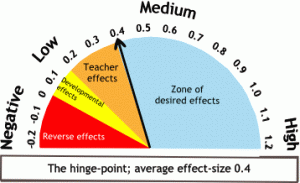This is post number eight in a ten part blog series (you may click here to start from the beginning).
This blog series serves to highlight the most significant findings from John Hattie’s 2012 work, Visible Learning for Teachers: Maximizing Impact on Learning and their applications to our classrooms. His work has given educators quantifiable insights that have no parallel in the field of education.
Need an introduction or a crash course on the effect sizes referenced below? An effect size of 0.40 is what Hattie refers to as a hinge-point regarding what is significantly effective or at “a level where the effects of innovation enhance achievement in such a way that we can notice real-world differences” (Hattie, 2009). Anything between a 0.00 and 0.39 is growth, but is not considered significant growth. Anything below a 0.00 is considered detrimental to student growth.
Number 3 – Response to Intervention (effect size = 1.07)
Response to intervention (RTI) strategies are a powerful way to provide individualized and targeted instruction for students in some of the greatest need of this attention. Hattie identifies RTI as “an educational approach that provides early, systematic assistance to children who are struggling in one or many areas of their learning. The goal of RTI is for students to respond to the intervention, close gaps, and reach a point where they can independently sustain growth in relation to their peers. When a student does not respond to RTI it may trigger the need for an evaluation to determine if the student qualifies for special education services.
This video provides a comprehensive and concise summary of RTI:
Application to the Classroom
As previously mentioned in the post about number eight on the list (comprehensive interventions for learning disabled students) the United States Department of Education has one of the best resources for identifying the best research-based interventions via their What Works Clearinghouse website (http://ies.ed.gov/ncee/wwc/). You are able to filter your desired instructional need by topic and grade level and are given a list of interventions with their respective improvement index, effectiveness rating, and extent of evidence related to the intervention. There are a plethora of researched interventions that can help to guide educators to best meet students’ needs.
A Random Mention
Number 136 out of 150 – Teacher Subject Matter Knowledge (effect size 0.09)
Teacher subject matter knowledge was one of the lowest scoring areas studied. Hattie asserts that effective teaching is more about “how teachers see the surface and deeper understandings of the subjects that they teach, as well as their beliefs about how to teach and understand when students are learning and have learned the subject” (2012, p. 28). This should ring true for any great educator that understands that it is not so much about what the teacher knows, but instead about what the student learns.
A Peek at the Bottom 10
Number 143 out of 150 – School Multi-grade/age Classes (effect size 0.04)
This research area refers to classes in which students from more than one grade level are taught in the same room and by the same teacher. One perceived advantage of this methodology is that educators can provide more flexible grouping and meet different learning styles and paces. Hattie shares that overall “the effects from multi-grade classes compared to single-age classes are not compelling enough to argue for the effectiveness of one over the other” (2009, p. 93).
For more from this blog series view the following posts:
#8 – Comprehensive Interventions for Learning Disabled Students
#5 – Providing Formative Evaluation of Programs
Hattie, J., Visible Learning: A Synthesis of Over 800 Meta-Analyses Relating to Achievement (2009)
Hattie, J. Visible Learning for Teachers: Maximizing Impact on Learning (2012)
http://visible-learning.org/glossary/#4_Teacher_credibility
Response to Intervention: A Tiered Approach to Instructing All Students https://www.youtube.com/watch?v=nkK1bT8ls0M
Effect size image retrieved from: http://www.learningandteaching.info/teaching/what_works.htm





Leave a Reply